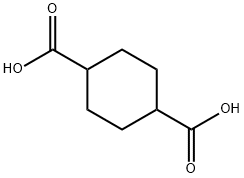1,4-Cyclohexanedicarboxylic acid
Synonym(s):1,4-CHDA-HP
- CAS NO.:1076-97-7
- Empirical Formula: C8H12O4
- Molecular Weight: 172.18
- MDL number: MFCD00001465
- EINECS: 214-068-6
- SAFETY DATA SHEET (SDS)
- Update Date: 2024-12-18 14:15:30

What is 1,4-Cyclohexanedicarboxylic acid?
Chemical properties
white fine crystalline powder
The Uses of 1,4-Cyclohexanedicarboxylic acid
1,4-Cyclohexanedicarboxylic acid may be used in the synthesis of:
- polyesters
- polyamides
- poly(butylene adipate-co-butylene 1,4-cyclohexanedicarboxylate) copolyester
- various polyester polyols
Definition
ChEBI: 1,4-cyclohexanedicarboxylic acid is a dicarboxylic acid that is cyclohexane substituted by carboxy groups at positions 1 and 4.
General Description
1,4-Cyclohexanedicarboxylic acid (1,4-CHDA) has cyclohexane based structure. CHDA has better weatherability, higher impact strength, and faster stress relaxation. CHDA exhibits three isomeric forms:
- axial, axial (a,a) trans-isomer
- equatorial, equatorial (e,e) trans-isomer
- a,e cis-isomer
Flammability and Explosibility
Non flammable
Properties of 1,4-Cyclohexanedicarboxylic acid
| Melting point: | 164-167 °C(lit.) |
| Boiling point: | 262.49°C (rough estimate) |
| Density | 1.2104 (rough estimate) |
| refractive index | 1.4450 (estimate) |
| Flash point: | 235°C |
| storage temp. | Sealed in dry,Room Temperature |
| form | Powder |
| pka | 4.38±0.10(Predicted) |
| color | White to off-white |
| Water Solubility | SOLUBLE |
| BRN | 1870377 |
| InChI | InChI=1S/C8H12O4/c9-7(10)5-1-2-6(4-3-5)8(11)12/h5-6H,1-4H2,(H,9,10)(H,11,12) |
| CAS DataBase Reference | 1076-97-7(CAS DataBase Reference) |
| NIST Chemistry Reference | 1,4-Cyclohexanedicarboxylic acid(1076-97-7) |
| EPA Substance Registry System | 1,4-Cyclohexanedicarboxylic acid (1076-97-7) |
Safety information for 1,4-Cyclohexanedicarboxylic acid
| Signal word | Warning |
| Pictogram(s) |
 Exclamation Mark Irritant GHS07 |
| GHS Hazard Statements |
H302:Acute toxicity,oral H319:Serious eye damage/eye irritation |
| Precautionary Statement Codes |
P264:Wash hands thoroughly after handling. P264:Wash skin thouroughly after handling. P270:Do not eat, drink or smoke when using this product. P280:Wear protective gloves/protective clothing/eye protection/face protection. P301+P312:IF SWALLOWED: call a POISON CENTER or doctor/physician IF you feel unwell. P305+P351+P338:IF IN EYES: Rinse cautiously with water for several minutes. Remove contact lenses, if present and easy to do. Continuerinsing. P337+P313:IF eye irritation persists: Get medical advice/attention. |
Computed Descriptors for 1,4-Cyclohexanedicarboxylic acid
| InChIKey | PXGZQGDTEZPERC-UHFFFAOYSA-N |
| SMILES | C1(C(O)=O)CCC(C(O)=O)CC1 |
New Products
Tert-butyl bis(2-chloroethyl)carbamate 4-Methylphenylacetic acid N-Boc-D-alaninol N-BOC-D/L-ALANINOL N-octanoyl benzotriazole 3-Morpholino-1-(4-nitrophenyl)-5,6-dihydropyridin- 2(1H)-one Furan-2,5-Dicarboxylic Acid DIETHYL AMINOMALONATE HYDROCHLORIDE 1,1’-CARBONYLDIIMIDAZOLE R-2-BENZYLOXY PROPIONIC ACID 1,1’-CARBONYLDI (1,2-4 TRIAZOLE) N-METHYL INDAZOLE-3-CARBOXYLIC ACID (2-Hydroxyphenyl)acetonitrile 4-Bromopyrazole 5-BROMO-2CYANO PYRIDINE 5,6-Dimethoxyindanone 5-broMo-2-chloro-N-cyclopentylpyriMidin-4-aMine 2-(Cyanocyclohexyl)acetic acid 4-methoxy-3,5-dinitropyridine 1-(4-(aminomethyl)benzyl)urea hydrochloride 2-aminopropyl benzoate hydrochloride diethyl 2-(2-((tertbutoxycarbonyl)amino) ethyl)malonate tert-butyl 4- (ureidomethyl)benzylcarbamate Ethyl-2-chloro((4-methoxyphenyl)hydrazono)acetateRelated products of tetrahydrofuran








You may like
-
 1,4-Cyclohexanedicarboxylic Acid (cis- and trans- mixture) CAS 1076-97-7View Details
1,4-Cyclohexanedicarboxylic Acid (cis- and trans- mixture) CAS 1076-97-7View Details
1076-97-7 -
 1,4-Cyclohexanedicarboxylic, 99% CAS 1076-97-7View Details
1,4-Cyclohexanedicarboxylic, 99% CAS 1076-97-7View Details
1076-97-7 -
 1,4-Cyclohexanedicarboxylic acid CAS 1076-97-7View Details
1,4-Cyclohexanedicarboxylic acid CAS 1076-97-7View Details
1076-97-7 -
 1,4-Cyclohexanedicarboxylic acid CAS 1076-97-7View Details
1,4-Cyclohexanedicarboxylic acid CAS 1076-97-7View Details
1076-97-7 -
 1975-50-4 98%View Details
1975-50-4 98%View Details
1975-50-4 -
 14714-50-2 (2-Hydroxyphenyl)acetonitrile 98+View Details
14714-50-2 (2-Hydroxyphenyl)acetonitrile 98+View Details
14714-50-2 -
 118753-70-1 98+View Details
118753-70-1 98+View Details
118753-70-1 -
 733039-20-8 5-broMo-2-chloro-N-cyclopentylpyriMidin-4-aMine 98+View Details
733039-20-8 5-broMo-2-chloro-N-cyclopentylpyriMidin-4-aMine 98+View Details
733039-20-8
Statement: All products displayed on this website are only used for non medical purposes such as industrial applications or scientific research, and cannot be used for clinical diagnosis or treatment of humans or animals. They are not medicinal or edible.